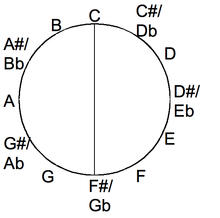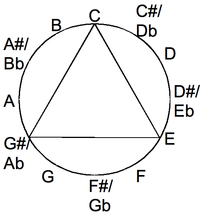

Repetitive tunings are a type of alternative tunings for the guitar. A repetitive tuning begins with a list of notes that is duplicated, either at unison or at higher octaves.
Among regular tunings, there are four repetitive-tunings (besides trivially repetitive tunings such as C-C-C-C-C-C); this article discusses three minor-thirds tuning, major-thirds tuning, and augmented-fourths tuning (but not major seconds tuning, which is not repetitive on six strings). Among open tunings, there are repetitive versions of open C tuning and open G tuning, which have been associated with the English and Russian guitars, respectively.
Repetition eases the learning of fretboard and chords and eases improvisation. For example, in major-thirds tuning, chords are raised an octave by shifting fingers by three strings on the same frets.
Repetitive tunings are listed after their number of open pitches. For example, the repetitive open-C tuning C-E-G-C-E-G has three open-pitches, each of which is associated with repeated notes {(C,C), (E,E), (G,G)}.
One

The trivial tuning repeats the same note every string. It is also called a unison regular tuning.
- C-C-C-C-C-C.
Other trivial-tunings repeat their single notes on a higher octave (or on higher octaves), for example,
- C-C-c-c-c'-c'.
Two
The following tunings repeat their notes on a higher octave after two strings:
- Augmented-fourths tuning, for example, B-F-b-f-b'-f'.
Any note fingered on one string can be fingered on two other strings. Thus chords can be fingered in many ways in augmented-fourths tuning. It is also a regular tuning in which the interval between its strings is a tritone (augmented fourth).
- A cittern tuning, such as C-G-c-g-c'-g'.
There are other tunings for the cittern.
- Alternating fourths and fifths tuning, such as A1-D2-A2-D3-A3-D4. (ADADAD)
This kind of tuning can also be called modal D or open D5 as it contains a D chord without a third. It is also used on other instruments, e.g. fiddle, mandolin and the Irish bouzouki.
Three


The following tunings repeat their notes after three strings:
- Major-thirds tuning, such as E-G♯-c-e-g♯-c' and
- D♯-G-B-D♯-G-B-D♯,
Chord inversion is especially simple in major-thirds tuning. Chords are inverted simply by raising one or two notes three strings. The raised notes are played with the same finger as the original notes. The major-thirds tuning is also a regular tuning having a major third interval between strings.
- Open G tuning, which is used as D', G', B, D, g, b, d' for the (7-string) Russian guitar.
- Open C tuning. For the English guitar's open C tuning, there are ten strings—of which the highest eight are paired in four courses (duplicated strings), C E GG cc ee gg.
Four

In each minor-thirds tuning, every interval between successive strings is a minor third. It repeats its open-notes after four strings. Doubled notes have different sounds because of differing "string widths, tensions and tunings, and reinforce each other, like the doubled strings of a twelve string guitar add chorusing and depth," according to William Sethares.
In the minor-thirds tuning beginning with C,
- C-D♯-F♯-a-c-d♯
the open strings contain the notes (c, d♯, f♯) of the diminished C chord. The minor-thirds tuning is also a regular tuning, which has a minor third interval between consecutive strings.
See also
- Scordatura, alternative tunings of stringed instruments
- Stringed instrument tunings
Notes
- ^ Kirkeby (2012, "Fretmaps, major chords: Major Triads"): Kirkeby, Ole (1 March 2012). "Major thirds tuning". m3guitar.com. cited by Sethares (2011) and Griewank (2010, p. 1). Retrieved 10 June 2012.
- ^ Griewank (2010, p. 10)
- Sethares (2001, "Regular tunings", p. 53; and "The augmented fourths tuning" 60):
Sethares, Bill (2001). "Regular tunings". Alternate tuning guide (PDF). Madison, Wisconsin: University of Wisconsin; Department of Electrical Engineering. pp. 52–67. Retrieved 9 September 2012.
- Sethares (2001, "The augmented fourth tuning", p. 60)
- Sethares (2001i, "Instrumental tunings: Cittern tuning two, p. 42)
- Sethares (2001i, pp. 34 and 41–42)
Sethares, Bill (2001i). "Instrumental tunings". Alternate tuning guide (PDF). Madison, Wisconsin: University of Wisconsin; Department of Electrical Engineering. pp. 34–51. Retrieved 12 September 2012.
- Sethares (2001, "The major third tuning", pp. 56–57)
- Ophee, Matanya (ed.). 19th Century etudes for the Russian 7-string guitar in G Op. The Russian Collection. Vol. 9. Editions Orphee. PR.494028230.
- Ophee, Matanya (ed.). Selected Concert Works for the Russian 7-String Guitar in G open tuning. The Russian Collection. Vol. 10 ("X"). Editions Orphee. PR.494028240.
- Smith, Gerald Stanton (1984). Songs to seven strings: Russian guitar poetry and Soviet "mass song". Soviet history, politics, society, and thought. Indiana University Press. pp. 1–271. ISBN 978-0-253-35391-7.
- Timofeyev, Oleg V. (1999). The golden age of the Russian guitar: Repertoire, performance practice, and social function of the Russian seven-string guitar music, 1800-1850. Duke University, Department of Music. pp. 1–584. University Microfilms (UMI), Ann Arbor, Michigan, number 9928880.
- Sethares (2001o, The open C tuning, p. 18):
Sethares, Bill (2001o). "Open tunings". Alternate tuning guide (PDF). Madison, Wisconsin: University of Wisconsin; Department of Electrical Engineering. pp. 16–33. Retrieved 9 September 2012.
- Hannu Annala; Heiki Mätlik (2007). "Composers for other plucked instruments: Rudolf Straube (1717-1785)". Handbook of Guitar and Lute Composers. Translated by Katarina Backman. Mel Bay. p. 30. ISBN 978-0-7866-5844-2.
- ^ Sethares (2001, "The minor third tuning", p. 54)
References
- Griewank, Andreas (1 January 2010), Tuning guitars and reading music in major thirds, Matheon preprints, vol. 695, Berlin: DFG research center "MATHEON, Mathematics for key technologies" Berlin, MSC-Classification 97M80 Arts. Music. Language. Architecture. Postscript file and Pdf file, archived from the original on 8 November 2012
- Sethares, William A. (2011). "Alternate tuning guide". Madison, Wisconsin: University of Wisconsin; Department of Electrical Engineering. 2010 PDF version by Bill Sethares. Retrieved 19 May 2012.
| Guitar tunings | |||||||||||||||
|---|---|---|---|---|---|---|---|---|---|---|---|---|---|---|---|
| |||||||||||||||
| |||||||||||||||
| |||||||||||||||
| |||||||||||||||
| |||||||||||||||